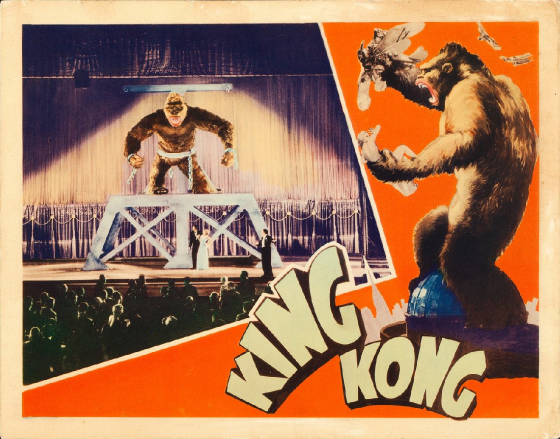|
|
 |
|

(1933, directed by Ernest B. Schoedsack and Merian C. Cooper)
- inducted 2018 –
“King Kong is the source. It is the font from which American commercial cinema has flowed for decades. Its influence
can be overt, as it is in Jurassic Park or Star Wars. Its influence can be subtle, as it is in O Brother
Where Art Thou or Dead Ringers or even in Citizen Kane itself. Its influence may not be obvious, but it’s
almost certainly there. There may be other films that are as influential as Kong. There are none that are MORE
influential.
“Unlike many of its inheritors, King Kong is surprisingly complex. Many films intended for the largest of mass
audiences offer every viewer the same experience, like an amusement park ride. But not Kong. By contrast, it is a Rorschach
test. The audience gets what it brings to it. Is Carl Denham a hero or a villain? Is the film an admiring allegory for colonialism
or is it a critique? Is Kong a lover or a rapist or an allegory for an insecure adolescent suitor? It may be all of these
things, or even none of them, depending on where one is in life when watching the film. I once compared Kong’s rampage
in New York City to Melvin Van Peebles’s Sweet Sweetback’s Badasssss Song, and I was only halfway joking.
“Like many great films, King Kong is bottomless. It repays multiple viewings across a long lifetime. I first
saw King Kong when I was nine years old on a Saturday afternoon when one of the television stations was showing a bunch
of monster movies. I’m (mumble mumble) years old now, and when I watched it for this essay, it was just as fresh and
compelling as it was when I was a kid. Maybe more so. So many films lose their magic when we age, but Kong remains
evergreen.
“I’ve seen King Kong with an audience four or five times. I never pass an opportunity to see it again in a theater.
Even eighty five years after it was made, it still casts a spell on the audience like no other movie that I’ve ever
seen. I’ve never seen Kong with an audience that wasn’t into it. If I happen to stumble upon King Kong
on television, it’s a film that compels me to watch it. You can’t take your eyes off of it. Part of that is the
character of Kong himself. Kong is one of the great tragic monsters, perhaps the apotheosis of the tragic monster. Kong’s
principal creator, the great Willis O’Brien, imbued Kong with something like a soul. If this wasn’t so, no one
would cry as the big ape takes his tumble off the Empire State Building. And yet they do. It’s one of the great conjuring
tricks in all of the arts, to take a puppet made of lambswool and steel and to imbue it with the breath of life and a divine
spark. Kong is a magnificent entertainment, it’s true, but it’s also a miracle, truly the Eighth Wonder
of the World.
“King Kong is the source.
“King Kong is movies.”
~ Christianne Benedict
|
 |
|
Principal cast: Fay Wray, Robert Armstrong, Bruce Cabot, Frank Reicher, Sam Hardy, Noble Johnson, Steve Clemente,
James Flavin, with uncredited appearances by Roscoe Ates, Merian C. Cooper, Carlotta Monti, Ernest B. Schoedsack, Jim Thorpe
and Victor Wong
Screenplay by: James Creelman and Ruth Rose, with additional uncredited contributions by Leon Gordon
From an idea conceived by Merian C. Cooper and Edgar Wallace
Executive producer: David O. Selznick
Director of photography: Eddie Linden, J.G. Taylor, Vernon Walker
Film editing by: Ted Cheesman
Original music by: Max Steiner
Sound by: Murrey Spivack (sound designer and sound effects), Earl A. Wolcott (sound recordist)
All other crew not credited:
Produced by: Merian C. Cooper and Ernest B. Schoedsack
Production design by: Carroll Clark
Costume design by: Walter Plunkett
Makeup by: Mel Berns, Sam Kaufman
Hair stylist: Dotha Hippe
Visual effects supervisor: Willis O’ Brien
USA
Duration: 100 minutes
Languages: English
Filmed in black and white
Sound mix: Mono (RCA Photophone System)
Aspect ratio: 1.37:1
Produced and released in USA by RKO Radio Pictures
Premiered in New York City on March 2, 1933
Awards and honors:
- National Film Registry selection, 1991
- Selected as one of Roger Ebert’s “Great Movies,” 3 February 2002
|
 |
|
|
 |
|
|
 |
|
|
|
|
|
|
 |

